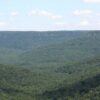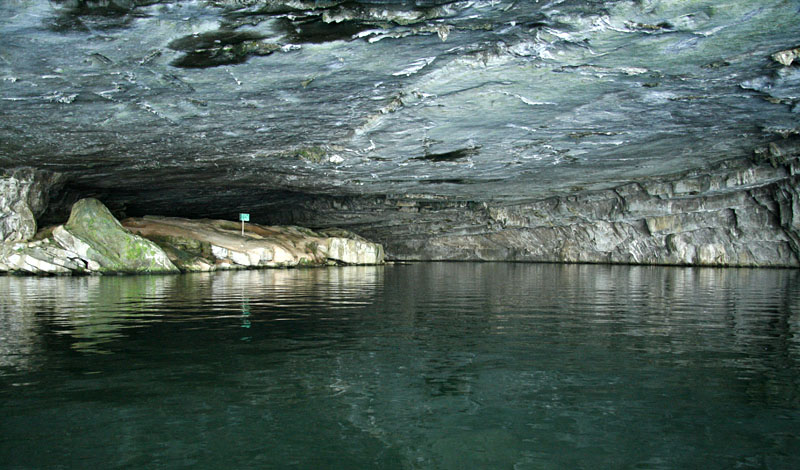
Experience History and Nature at Nickajack Cave
Historic Nickajack Cave, partially flooded by its namesake lake, is considered to be biologically one of the most important caves in Tennessee. This is primarily because of the thousands of gray bats that inhabit it from late April through early October, with peak numbers being in June and July. The gray bat, a medium-sized short-eared species, is one of over a dozen in Tennessee and is listed as federally endangered.
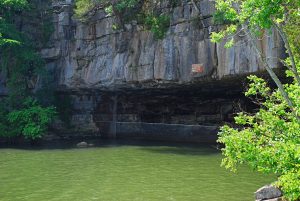 During the time of year they roost in Nickajack Cave, which is also when they give birth to their young, they emerge each evening after sundown from the mouth of the cave to search for food in a continuous stream estimated to contain over 100,000 bats and lasting about 45 minutes. It is estimated they consume 274,000 pounds of insects a year. Although they prefer mayflies and stoneflies, they also eat mosquitoes, caddis flies, beetles, moths and other aquatic insects. In the fall, the bats move to cooler caves for hibernation.
During the time of year they roost in Nickajack Cave, which is also when they give birth to their young, they emerge each evening after sundown from the mouth of the cave to search for food in a continuous stream estimated to contain over 100,000 bats and lasting about 45 minutes. It is estimated they consume 274,000 pounds of insects a year. Although they prefer mayflies and stoneflies, they also eat mosquitoes, caddis flies, beetles, moths and other aquatic insects. In the fall, the bats move to cooler caves for hibernation.
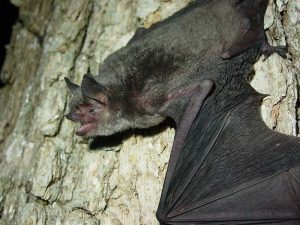 Since 2006 a fungus that causes white-nose syndrome in bats has spread from New York over much of the U.S. and Canada, killing millions of bats and resulting in the closure of many public caves. But there’s good news. In recent years scientists and conservationists have successfully treated bats for white-nose syndrome and released them back into the wild.
Since 2006 a fungus that causes white-nose syndrome in bats has spread from New York over much of the U.S. and Canada, killing millions of bats and resulting in the closure of many public caves. But there’s good news. In recent years scientists and conservationists have successfully treated bats for white-nose syndrome and released them back into the wild.
Cliff swallows also inhabit the cave, co-existing with the bats and building mud nests on the ceiling. The swallows eat the same insects as the bats, but during the day, while the bats feed at night.
Paddle to the Cave
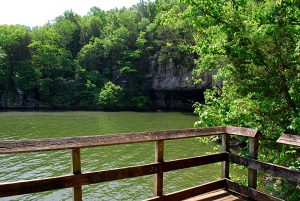 A popular way to view the evening emergence of bats is by paddling a canoe, kayak,or paddleboard to near the cave entrance. It’s a relatively short paddle from the Maple View Day Use Area boat ramp in New Hope. A slightly longer alternative trip would be to put in at the Cole City Creek boat ramp near Macedonia Baptist Church, on the opposite shore of the bay from Nickajack Cave.
A popular way to view the evening emergence of bats is by paddling a canoe, kayak,or paddleboard to near the cave entrance. It’s a relatively short paddle from the Maple View Day Use Area boat ramp in New Hope. A slightly longer alternative trip would be to put in at the Cole City Creek boat ramp near Macedonia Baptist Church, on the opposite shore of the bay from Nickajack Cave.
If you prefer to go with a group, the following outfitters offer guided paddle trips to the cave during the summer:
Scenic City Safari Shuttles and Outfitters
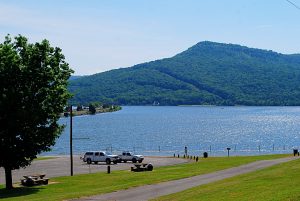 If you’d like to simply walk to see the bats, a 1,000-foot boardwalk leads from the Maple View Day Use Area through the woods along the shoreline to an observation platform overlooking the cave entrance, though not quite as close as you can get by water. It may be about a half-hour after sunset before you see many bats. The best method of spotting them from the overlook is to look directly overhead. They tend to turn and follow the tree line along the shore.
If you’d like to simply walk to see the bats, a 1,000-foot boardwalk leads from the Maple View Day Use Area through the woods along the shoreline to an observation platform overlooking the cave entrance, though not quite as close as you can get by water. It may be about a half-hour after sunset before you see many bats. The best method of spotting them from the overlook is to look directly overhead. They tend to turn and follow the tree line along the shore.
The Maple View site is open 6 a.m. to 9 p.m. Central Time from April through October. The Maple View area is minimally maintained, but there are a number of picnic tables and a pavilion. The restrooms are closed, but a portable outhouse is provided.
Some History of the Cave
A known landmark for hundreds of years, Nickajack Cave has served as a shelter for Native Americans and, later, river pirates. It was a source of saltpeter, used in making gunpowder, in both the War of 1812 and for the Confederacy in the Civil War. Although there seems to be a variety of opinions on the origin of the name “Nickajack,” there was once a Cherokee town of Nickajack located between the cave and the Tennessee River.
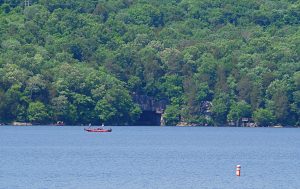
Both the town of Nickajack and the nearby town of Running Water were destroyed by territorial militias in 1794. Various commercial interests ran boat tours into the cave off and on since 1872. Before the lake existed, a creek ran out of the cave. The entrance once measured 140 feet in width by 50 feet in height, but since the formation of Nickajack Lake in 1967 flooded the entrance, the height is only 20 to 25 feet. The entrance was fenced off to keep boats out in 1981 in order to protect the bats. In 1992, TWRA designated Nickajack Cave as Tennessee’s first non-game wildlife refuge.
Directions to Nickajack Cave
Nickajack Cave is located in New Hope, about 25 miles from downtown Chattanooga. Going west on I-24, take exit 161 at Haletown. Turn left on Highway 156. In about 5 miles, you’ll see the cave across the water on your left. The Maple View Day Use Area will be on the left immediately upon passing the lake.
Article by Bob Butters, Nickajack Naturalist
Gray Bat Photo: Adam Mann, Environmental Solutions and Innovations



